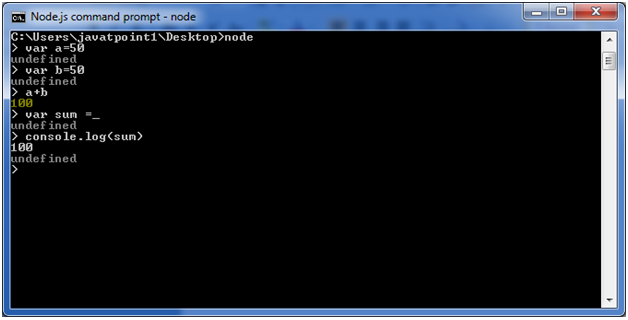Node.js Timer - Node.js टाइमर
टाइमर फ़ंक्शन सेट करें:
setImmediate (): इसका उपयोग setImmediate को निष्पादित करने के लिए किया जाता है।
setInterval (): इसका उपयोग समय अंतराल को परिभाषित करने के लिए किया जाता है।
setTimeout (): () - इसका उपयोग देरी के बाद एक बार कॉलबैक निष्पादित करने के लिए किया जाता है।
टाइमर कार्य साफ़ करें:
ClearImmediate (तात्कालिक ऑबजेक्ट): इसका उपयोग एक तत्काल ऑबजेक्ट को रोकने के लिए किया जाता है, जैसा कि setImmediate द्वारा बनाया गया है
ClearInterval (इंटरवलऑब्जेक्ट): इसका उपयोग इंटरवलऑब्जेक्ट को रोकने के लिए किया जाता है, जैसा कि setInterval द्वारा बनाया गया है
clearTimeout (timeoutObject): यह टाइमआउट ऑबजेक्ट को रोकता है, जैसा कि सेटटाइमआउट द्वारा बनाया गया है
This example will set a time interval of 1000 millisecond and the specified comment will be displayed after every 1000 millisecond until you terminate.
File: timer1.js
setInterval(function() {
console.log("setInterval: Hey! 1 millisecond completed!..");
}, 1000);
- var i =0;
- console.log(i);
- setInterval(function(){
- i++;
- console.log(i);
- }, 1000);
Node.js Timer setTimeout() Example
- setTimeout(function() {
- console.log("setTimeout: Hey! 1000 millisecond completed!..");
- }, 1000);
This example shows time out after every 1000 millisecond without setting a time interval. This example uses the recursion property of a function.
- var recursive = function () {
- console.log("Hey! 1000 millisecond completed!..");
- setTimeout(recursive,1000);
- }
- recursive();
Node.js setInterval(), setTimeout() and clearTimeout()
Let's see an example to use clearTimeout() function.- function welcome () {
- console.log("Welcome to JavaTpoint!");
- }
- var id1 = setTimeout(welcome,1000);
- var id2 = setInterval(welcome,1000);
- clearTimeout(id1);
- //clearInterval(id2);
Node.js setInterval(), setTimeout() and clearInterval()
Let's see an example to use clearInterval() function.- function welcome () {
- console.log("Welcome to JavaTpoint!");
- }
- var id1 = setTimeout(welcome,1000);
- var id2 = setInterval(welcome,1000);
- //clearTimeout(id1);
- clearInterval(id2);
































